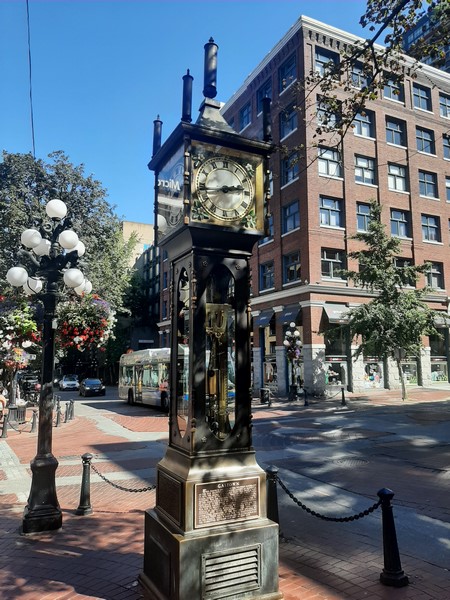This steam-powered clock , Gastown’s most famous (though nowhere near oldest) landmark, is one of the only functioning steam-powered clocks in the world. It was designed and built in 1977 (to marked the completion of the city’s revitalization project) by Canadian clockmaker Raymond L. Saunders to cover a steam grate, part of Vancouver‘s distributed steam heating system as a way to harness the steam and to prevent street people from sleeping on the spot in cold weather.
At the time, it was considered as either the first (the world’s first steam clock is often credited to British engineer John Inshaw, who supposedly built the clock to attract customers to his pub in Birmingham, UK during the mid-19th century) or second steam-powered clock ever built. Saunders has since built six different public steam clocks for clients such as the city of Otaru, Japan, and the Indiana State Museum. In 2010, he built a clock for Vancouver’s York House School‘s 78th birthday.
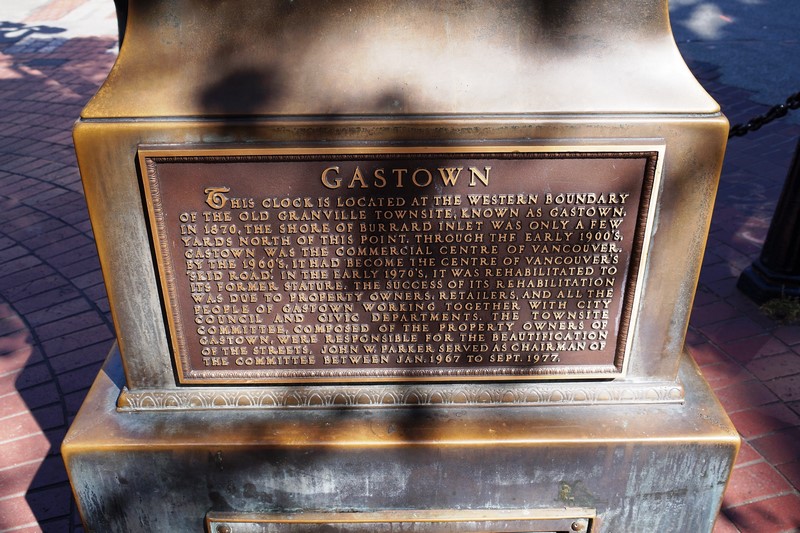
Plaque at West Side reads:
Gastown
This clock is located at the western boundary of the old Granville townsite, known as Gastown. In 1870, the shore of Burrard Inlet was only a few yards north of this point. Through the early 1900’s, Gastown was the commercial centre of Vancouver. By the 1960’s, it had become the centre of Vancouver’s ‘skid road’. In the early 1970’s, it was rehabilitated to its former stature. The success of its rehabilitation was due to property owners, retailers, and all the people of Gastown working together with city council and civic departments. The townsite committee, composed of the property owners of Gastown, were responsible for the beautification of the streets. John W. Parker served as chairman of the committee between Jan. 1967 and Sept. 1977.
Originally, its design was faulty and, after a breakdown, had to be powered by electricity. As it had become a major tourist attraction, the steam mechanism was completely restored with the financial support ($58,000) of local businesses and private donors and, although it is of modern invention, is promoted as a heritage feature. The Gastown clock is not completely powered by steam as the steam engine that drives the clock mechanism is assisted by an electric motor. Weighing over two tons, the component parts the clock cost $42,000.
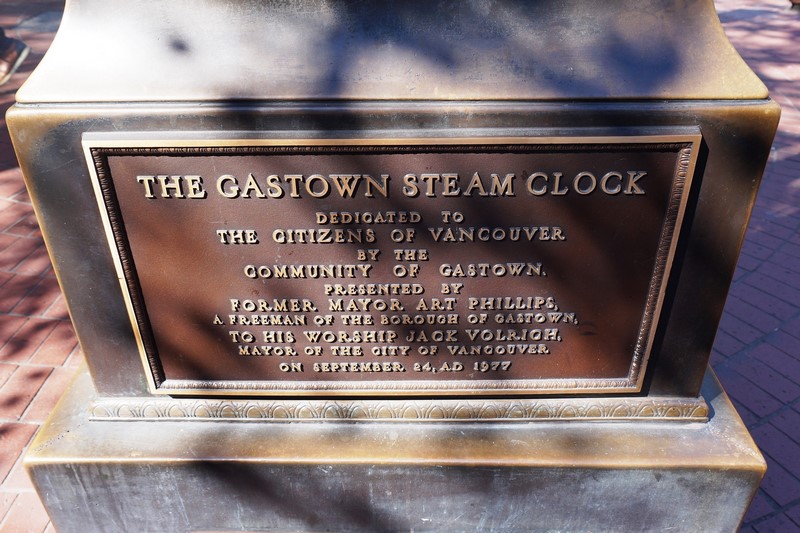
Plaque at South Side
(facing into the street) reads:
The Gastown Steam Clock
Dedicated to the citizens of Vancouver by the community of Gastown. Presented by former Mayor Art Phillips, a freeman of the borough of Gastown, to his worship Jack Volrich, Mayor of the City of Vancouver on September 24, AD 1977
The steam used to power a miniature steam engine in the base of the clock is low pressure downtown-wide steam heating network (from the Central Heat Distributors plant adjacent to the Georgia Viaduct) which, in turn, drives a chain lift. The chain lift moves steel balls upward, where they are unloaded and roll to a descending chain. The weight of the balls on the descending chain drives a conventional pendulum clock escapement, geared to the hands on the four faces.
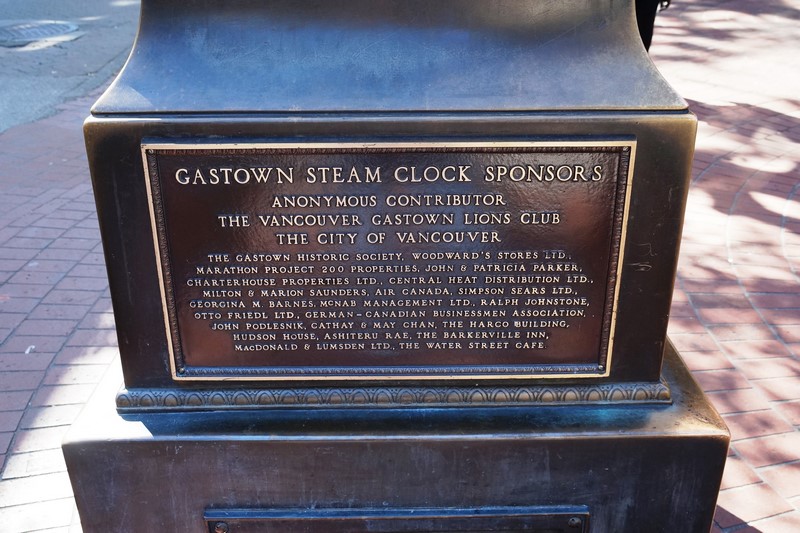
Plaque at East Side reads:
Gastown Steam Clock Sponsors
Anonymous Contributor
The Vancouver Gastown Lions Club
The City of Vancouver
The Gastown Historic Society, Woodward’s Stores Ltd., Marathon Project 200 Properties, John & Patricia Parker, Charterhouse Properties Ltd., Central Heat Distribution Ltd., Milton & Marion Saunders, Air Canada, Simpson Sears Ltd., Georgina M. Barnes, McNab Management Ltd., Ralph Johnstone, Otto Friedl Ltd., German-Canadian Businessman Association, John Podlesnik, Cathay & May Chan, The Harco Building, Hudson House, Ashiteru Rae, The Bakersville Inn, MacDonald & Lumsden Ltd., The Water Street Café
The gravity driven “falling ball” drive was ‘engineered’ by Douglas L. Smith. The steam also powers the clock’s sound production, with whistles being used instead of bells to produce the Westminster “chime” and to signal the time. It shoots steam at the top of every hour and announces quarter hours, sounding the chimes on 5 brass steam whistlers, with the Westminster Quarters; a common clock chime melody that’s also used by London’s “Big Ben.” In October 2014, the clock was temporarily removed for major repairs by its original builder, and was reinstalled January 2015.
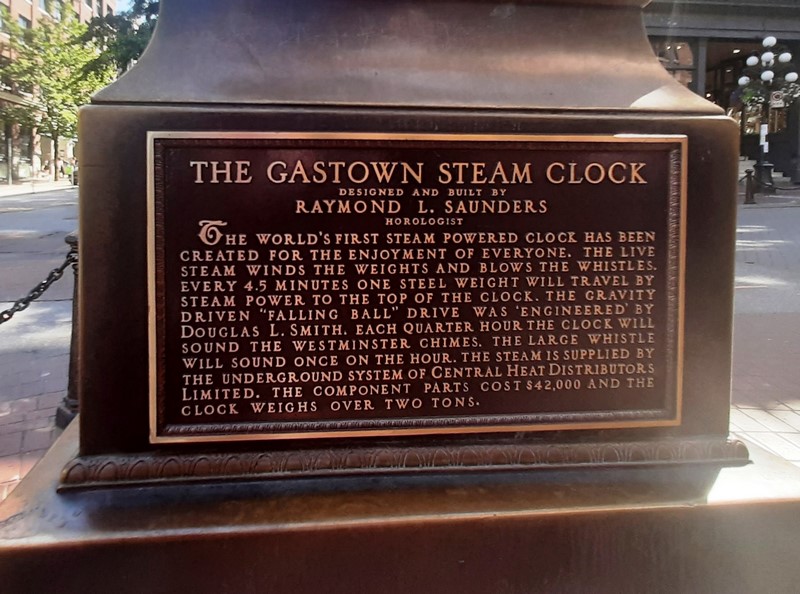
Plaque at North Side reads:
The Gastown Steam Clock
Designed and built by
Raymond L. Saunders
Horologist
The world’s first steam powered clock has been created for the enjoyment of everyone. The live steam winds the weights and blows the whistles. Every 4.5 minutes one steel weight will travel by steam power to the top of the clock. The gravity driven “falling ball” drive was ‘engineered’ by Douglas L. Smith. Each quarter hour the clock will sound the Westminster Chimes. The large whistle will sound once on the hour. The steam is supplied by the underground system of Central Heat Distributors [typo – should be Distribution] Limited. The component parts cost $42,000 and the clock weighs over two tons.

